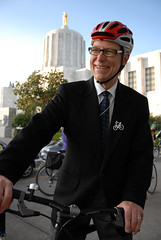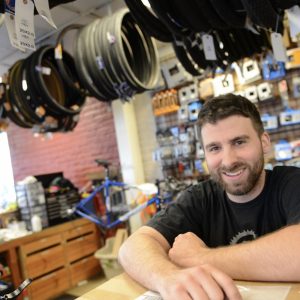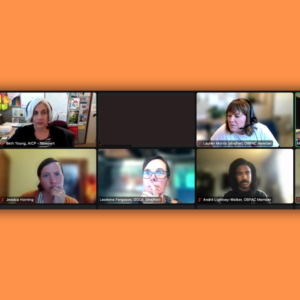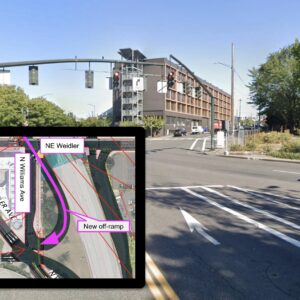[This article was written by Daniel Ronan, the student representative on the Oregon Bicycle and Pedestrian Advisory Committee.]
The City of Portland’s Bicycle Advisory Committee (PBAC) is mentioned frequently here on BikePortland, but did you know that the Oregon Department of Transportation (ODOT) also has an advisory committee that deals with bicycling projects and issues?
The Oregon Bicycle and Pedestrian Advisory Committee (OBPAC) is an eight member, governor appointed committee that serves as the intermediary body between the public and ODOT, via the Oregon Transportation Commission. The group meets quarterly in communities statewide.
Jerry Norquist, Executive Director of Cycle Oregon, serves as the committee chair. The committee also includes representatives from local government, Oregon Recreational Trails, the environmental community, youth, and three at large members.
OBPAC’s largest task is the administration of its biannual $5 million grant program (applications are due July 9th!). Grants are awarded to communities across Oregon to fund bicycle and pedestrian projects within the public right of way. The program has benefited communities as small as Vale, Oregon as well as Portland.
[Publisher’s note: At their monthly meeting tonight (6pm at the Lovejoy Room in City Hall), the CIty of Portland BAC will discuss how to select one local project for this grant program.]
For the 2012-2013 grant cycle, OBPAC has encouraged applicants, comprising cities and counties, to “think big” in the size of their project proposals.
The committee has also collaborated with ODOT in how best to distribute the first ever allocation of $1 million from the Urban Trail Fund. The fund, a part of House Bill 2001 from last year’s legislative session, works to create multi-use trails outside of the public right of way. Presenters from various governmental organizations, including ODOT, Oregon Parks and Recreation, and Metro inform the committee on transportation policy matters.
For the 2012-2013 grant cycle, OBPAC has encouraged applicants, comprising cities and counties, to “think big” in the size of their project proposals. In the past, the committee allocated smaller and more numerous grants, reflecting the group’s desire to fund wide-ranging projects in communities both large and small.
Given Ray LaHood’s recent announcement of a “sea change” in the nation’s transportation policy, setting walking and biking as equal to motor vehicle travel, the committee has expressed desire to fund larger projects in addition to smaller projects. (The committee sent a letter of thanks to LaHood at the beginning of May.) These larger projects, known as “signature projects,” as spelled out in the grant letter, “must provide community wide impacts, demonstrate that walking and bicycling can make significant contributions to our transportation needs and must include the highest quality design elements.”
Criteria for grading signature projects will consist of documentation in local plans, how much the project gives parity to walking and biking with motor vehicle travel, the level of design innovation and the demonstration of community commitment to walking and biking. In addition, OBPAC has set goals for reviewing and awarding grants which include: establishing a legacy, providing quality biking or walking experiences, accounting for need, connecting transportation systems, and enhancing livability or economic development.
The committee hopes to establish more details on the grant at their next meeting on May 20th and 21st in Klamath Falls (ODOT Offices, 2557 Altamont Dr.). Grants for the 2012-2013 grant cycle will be awarded sometime in October 2010. OBPAC welcomes and encourages citizens to attend its meetings and speak to the committee during the public comment period. Meeting agendas and documents are located on OBPAC’s website.








Thanks for reading.
BikePortland has served this community with independent community journalism since 2005. We rely on subscriptions from readers like you to survive. Your financial support is vital in keeping this valuable resource alive and well.
Please subscribe today to strengthen and expand our work.
This is good news, though it’s a little bit frightening how much weight the message of the federal DOT holds with them – put someone else in LaHood’s place saying “build more car infrastructure” and would this all fly out the window?
I guess it’s nice we can take advantage of this while we have it, though! 🙂
Bike riders, runners and walkers are never going away. Another step to “them getting it.”
How about paved shoulders on high speed rural roads? I ride out around North Plains a good bit, and really love it. But for some roads (like Jackson School Road, the lower part of Helvetia Road, and West Union, especially), there’s relatively little traffic, but it’s moving at really high speeds. Being passed by a car at 55 mph isn’t as big a deal when there’s 3 foot shoulder. But when there’s no shoulder, drivers kind of have to make up a passing distance, and they often fail to pass safely. How about a little room on the roads out there? Skyline Drive in Portland would be bicycle BLISS if it had a consistent 3 foot shoulder. They don’t even have to call them “bike lanes”, which should ease some of the backlash from bike haters.
That’s dreaming big, if you ask me. It would make cyclo tourism that much more appealing.
On second read, I think my plan would fail to win the grant, because it doesn’t have “design innovation”. It would make cycling lots more attractive and safe, but it wouldn’t have that all important “photo-op” factor for local politicians, would it?
Dreaming big would be a network of bicycle paths through rural areas separated from motorized traffic (they could still follow the main roads), that would make it feasible for average people to ride between towns and cities.
Think about that for cycle tourism, as well as just normal transportation.
“See all of Oregon by Bike, without ever having to worry about getting hit by a car!”
That might actually convince me to do some cycle tours. As it stands, no way. I’m never going to ride on the non-existent shoulder of a highway, sorry.
Expanding the shoulders of the road (or actually paving them in the first place) would be nice, but I really think some dedicated cycle paths through rural areas would be brilliant!
Dave, that WOULD be brilliant!!! Can you imagine a Springwater Corridor going over the Cascades and all the way to the Wallowas? What a nice ride that’d be. Actually, Washington state has a unimproved, gravel railbed trail from West to East called the John Wayne trail. It’s a mountain bike ride, though. Actually, I think that’d be a fine way to start. It’d sure be cheaper than a paved path, huh?
Can these funds be used for the Willamette Greenway project? Seems like the perfect candidate to me.
It would be cheaper, but a paved path used only by bicycles could be potentially paved with a rougher but more durable material than asphalt, and could potentially last decades with only very minor maintenance by the state. Even asphalt would last many many times longer than the parallel roads used by automobiles.
Obviously, I’m sure they’re not going to build out an entire network across the state at once. It would be great to see them build trails, for instance, between towns on the coast, or between Portland and some nearby outlying small towns, just to see how it works out. I think it would be a smash hit.
Other things I’d love to see from ODOT would be major bike/ped improvements on state highways within cities, like SE Powell Blvd, for instance. Painted crosswalks on a 40mph highway with bends in it just don’t work, you need signals, signage, etc. It may be a state highway, but where it goes through a city, it needs to fit the needs of the city.
Extend the Springwater Corridor Trail to Estacada/Faraday Road. Pave the existing portion from 252nd to Boring.
Buy Jerry a less dorky helmet
Dream big in a couple of other ways–banning studded automobile tires, and lowering every speed limit in the state by 10 MPH plus adding a zero to every speeding and aggressive driving fine.
Dare to actually try to control driver behavior!
re greenway projects, this money can only spent within existing rights of way
OMFG! An Oregon cross-state separated bicycle highway! Yes!! Now THAT’S innovative. Setting aside cyclo-tourism for the moment; THAT would for certain get thousands of **Portlanders**–and Oregonians statewide–on bikes who otherwise never would, just to give the thing a try in their own home turf, and eventually beyond. The business that would sprout up along the thing–hell, the CIVILIZATIONS that would–would catapult Portland from a nation-leading bike city to a global leader and top global destination for not only cyclo-tourism, but for evolved (de-volved??) living. Excites me as much as the prospect of a 20 MPH City of Portland (which would total remake the city into something nearly perfect).
How do I get on that ODOT advisory committee?
Dave, props baby.
Is anybody listening?
SEPARATED BIKEWAYS AND LOW URBAN SPEED LIMITS ARE ***THE*** TWO THINGS THAT WILL ELEVATE BIKE-RIDING FROM AN ALTERNATIVE TO A DOMINANT TRANSPO MODE. THERE IS NO OTHER WAY.
(get used to seeing me copy/paste that decree on blogs)
I think we would be surprised at how much business a bicycle network would bring to small towns in Oregon, by bringing people there who actually want to come *to* the town, and not just pass through at 55mph on the freeway and possibly stop for gas or a soda.
Also, think about things like separated bike paths from Sunriver to Bend. I’d bet quite a few people would take their bikes to Sunriver for vacation, and take day trips to Bend if they could easily do so (it’s only about 15 miles along the highway, under 2-hour ride at a very relaxed pace, even less at a faster pace).
In any case, it’s well worth thinking about.
@Charley – you may not have noticed, but when WashCo repaves a road these days, it gets nice shoulders. Check out the new stretch(es) of Cornelius Schefflin. Wonderful shoulders!
When the cars go away due to the imminent shortages of oil and gasoline, every road will be a paved bike path. Let’s be patient. The age of the automobile is almost over, even if it doesn’t look like it right now.
-Ian
look, craig #15 is screaming at us about something – separated bikeways – that are expensive to build and require right of way that isn’t available, and so will never be widespread or practical.
OTOH, Ian #19 is probably on to something – every local public street is already a paved bike facility, we just need to reign in the motorists a bit.
Sorry guys, I’d love to see carfree streets due to an oil crisis in the near future, but those gas guzzlers will transform into electric cars and we’ll have the same problems, with the exhaust pipe moved from the back of the car to the power plant.
We definitely need a holistic approach: slower speeds, road dieting, road user education, culture changes.. infrastructure is a key piece in this.
Infrastrucural change does take time, so I’ll be patient with that process while still pushing our political leaders to make smarter choices in how they shape our future roadways.
#20 BURR,
Non-cycling citizens largely report discomfort-with-sharing-the-road-with-motorists as the primary obstacle to getting on a bike.
Here’s to hoping that some people with political influence and the will can also have a vision to do what IS possible but is NOT part of current thinking. Separate bikeways implemented on a user-scale equal to motorways is that vision.
The politics and public consciousness of the entire nation are moving, embracing a paradigm shift toward active transportation, to improve citizens’ health and quality of life, decrease costs of transportation and health care, as well as slash use of fossil fuels and resultant pollution. We must sieze now on this collective momentum, before the political climate and public interest lose their potency.
Significant strides can be made only when cycling is comfortable, accessible, and the preferred choice for most short trips, for most citizens. Absent a complete system of separated bikeways, and the resultant public will, the vision will remain just that.
@Lynn, #18- I haven’t been on that road, but I’ll take a look. I thought that the roads I’ve been riding had pretty good, or new pavement. Actually, with the large drainage ditches beside the roads, I wonder if it might be impossible to create shoulders on some roads without encroaching onto fields. I still think it would be a terrific goal- especially on Skyline. Wouldn’t that be something!
#22 – my point is the city will never build a complete system of separated bikeways, because it is near physically impossible to do and the political will doesn’t exist to make it happen. The city has been at work for over 20 years on the system we have and it’s still not fully connected.
The best we can probably hope for is a few disconnected separated bikeways in the few remaining places that existing available right of way can be taken away from motorists or landowners without excessive opposition. These separated facilities are likely to continue to pose significant safety hazards to cyclists, since they will be designed by the same non-cycling engineers that gave us right-hook door-zone bike lanes and the Burnside-Couch interchange.
That being said, I’m certainly not opposed to building selected separated pathways in corridors where there would be limited interaction with motor vehicle traffic and they make sense, like in Sullivan’s Gulch, or along the Willamette east bank north from the Steel Bridge to Kelly Point or along the Willamette west bank south from South Waterfront to Lake Oswego.
London is doing it: http://road.cc/content/news/17421-boris-johnson-outlines-his-vision-londons-cycling-revolution
@craig: except London’s version of “bicycle superhighways” are mostly standard bike lanes as we know them, only painted blue the whole way.
that might be a very minor improvement, but as I’m sure Mikael Colville-Anderson (or anyone else with much sense) would tell you, just painting your bike lanes blue doesn’t make you Copenhagen.
I think Mayor Johnson is largely doing the same things we see here in the U.S. so often, and using language to make a project sound much more grand than it really is.
Look at the Netherlands idea of bicycle highways (which cover the whole country, by the way) and compare it to London’s. No comparison.
Separated bike paths work in the Netherlands because most of them run along canals with a very limited amount of intersections along their length. The only place similar conditions really exist in Portland is along the major waterways – Willamette R., Columbia R., Sullivan’s Gulch, Columbia Slough, Johnson Creek.